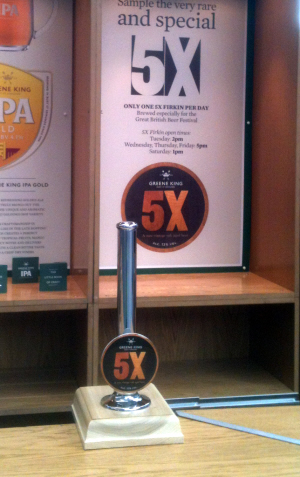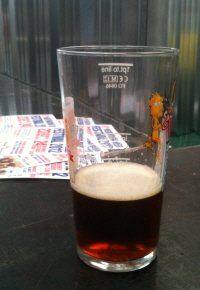
The unlikely handpump that lured the bloggerati — Greene King Old 5X on cask at the Great British Beer Festival, London, August 2012.
Top Tastings 2012
ABV: 12%
Origin: Bury St Edmunds, Suffolk, England
Website: www.greeneking.co.uk
It has to be admitted that these days the Greene King bar is rarely the hottest place to be at a beer festival. Yet at the Great British Beer Festival (GBBF) at Olympia, London, in August 2012, that expectation was turned on its head.
At an appointed time in the early afternoon of the first day’s trade session, many of the most influential beer opinion formers in Britain could be found gathering around the Suffolk brewer’s bar – top beer writers, widely read bloggers, international beer judges and various other industry figures.
And no, they hadn’t all suddenly undergone a mysterious conversion to the delights of Greene King IPA. Instead they were there for the GBBF debut of one of the most extraordinary beers brewed by an old established British cask ale brewery. The beer was Old 5X, a unique matured stock ale that has miraculously survived in an era when its brewer has become the biggest of Britain’s “new nationals”.
I’ve written about Old 5X at length before on this blog – but this was before I had a chance to taste it neat, as until very recently it was only made publically available as a component of blends. At 12% it’s strong stuff, brewed with roasted malt and rich cane sugar, with Challenger, First Gold and Target hops, but what’s more remarkable is the process used to produce it.
Following primary fermentation it’s matured for at least a year in two old oak vats holding 100 barrels (16,366l) each, retained by the brewery for the purpose, before being blended with younger beer for release. For years it’s been mixed with Burton Pale Ale, another beer not allowed out on its own, to make bottled speciality Strong Suffolk, and more recently it’s emerged in Old Crafty Hen.
Long maturation and blending were once common in brewing – at a certain stage in its history, porter was a blend of wood matured beer which had become flat and vinous, or “stale” as it was once termed, with young “mild” or “running” beer. Inevitably, wild yeasts and other microflora resident in the wood contributed a certain character and complexity, and often a sour or funky note, to vatted beer.
Before such practices were revived in the more experimental corners of the contemporary craft beer world, Greene King was the only British brewery at which they clung on, though like so many quirky old techniques they could be encountered more readily in Belgium. West Flemish oud bruin, once an everyday quencher in its region of origin and now a prized speciality, is brewed in a similar way, and the huge oak foeders still in use at Rodenbach in Roeselare bear obvious resemblance to GK’s vats.
GK long resisted suggestions from beer lovers to make Old 5X more widely available in its own right, insisting that nobody would want to drink it – widely interpreted as yet another sign of how out of touch the Bury St Edmunds brewery was with the way the specialist beer market is developing, and perhaps how dedicated it had become to the pursuit of blandness in the name of palatability.
So what changed the brewery’s mind? Apparently a long serving local CAMRA volunteer was due to retire and head brewer John Bexon suggested creating a special beer for him at the East Anglian Beer Festival, held at Bury. Instead the volunteer requested a cask of Old 5X. Contrary to John’s expectations, the cask rapidly sold out, prompting the brewery to repeat the experiment.
The cask version at GBBF, available as a limited edition of one nine gallon firkin (41l) a day, was a year-old ale kräusened with fresh beer. Served by the third pint (197ml) nip, it poured a hazy rich reddish brown with a thick yellow head. The aroma was beautifully full, rich and very fresh with chocolate and orange peel notes, and just a hint of sourish balsamic vinegar.
The palate was sherry-sweet, nicely matured and, to me, utterly luxurious, again with just a slight funky sweet-sour touch, almonds and citrus. The big, orangey and nuttily malty finish wasn’t quite as long as expected, but amazingly rounded for the strength.
I spoke to John at GBBF and he still seemed bemused, though pleased, with the interest in the beer. Let’s hope it prompts further releases, and perhaps a special edition bottle conditioned version.




















